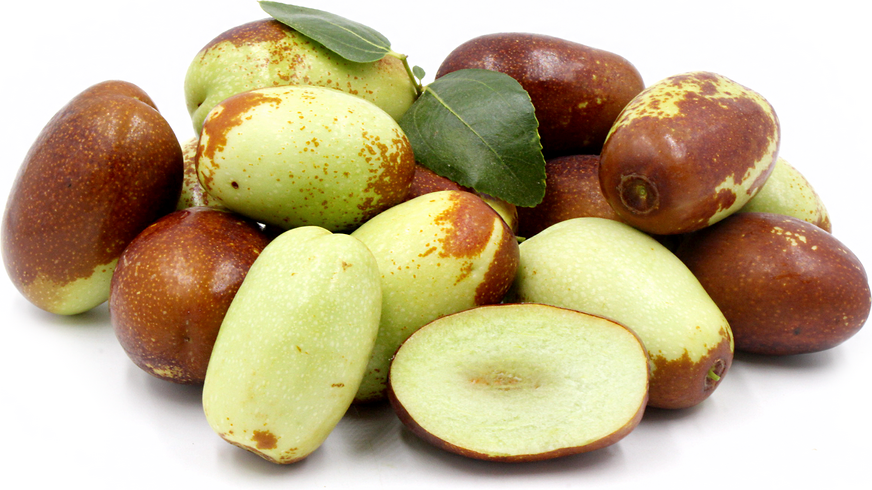


GA 866 Jujubes
Estimated Inventory, lb : 0
Description/Taste
GA 866 jujubes are a large jujube variety, averaging 3 to 5 centimeters in diameter, and have an elongated and plump, oval shape with rounded, curved ends. The skin is firm, smooth, and semi-thick, transitioning from green when unripe to yellow-green, red-brown, to mahogany with maturity. Underneath the surface, the flesh is crisp, airy, semi-aqueous, and pale green, encasing a small, central pit with seeds. GA 866 jujubes have a high sugar content, developing a concentrated sweetness with an apple-like flavor. As the fruits are left on the tree, the skin will begin to wrinkle, and the flesh becomes chewy and sticky, developing a date-like consistency.
Seasons/Availability
GA 866 jujubes are available in the early fall through winter.
Current Facts
GA 866 jujubes, botanically classified as Ziziphus jujuba, are one of the largest jujube varieties belonging to the Rhamnaceae family. The elongated, crisp fruits were bred at a research station in Chico, California, in the mid-20th century, and were a product of the most extensive jujube study within the United States. GA 866 jujubes were created from an unknown parentage, and the cultivar was also never given an official name before the research program was defunded in the late 1950s. In the modern-day, GA 866 jujubes are considered rare compared to more common jujubes such as li and lang, but growers appreciate the cultivar for its drought and cold tolerance, adaptability, high yields, and disease resistance. GA 866 jujubes are known for their concentrated sweetness and high sugar content, suitable for fresh eating and drying.
Nutritional Value
GA 866 jujubes are an excellent source of vitamin C, an antioxidant that strengthens the immune system, and are a good source of fiber to regulate the digestive tract. The fruits also contain minerals, including potassium to regulate fluid levels, zinc to fight off viruses, and lower amounts of calcium, phosphorus, and iron. In natural medicines, GA 866 jujubes are dried, steeped in boiling water, and made into a tea, used as a natural detoxifier.
Applications
GA 866 jujubes contain high amounts of sugar, which develops a sweet flavor that can be showcased in fresh, dried, and cooked applications. When fresh, the fruits are primarily consumed straight, out-of-hand with the pit discarded, or they can be sliced into fruit bowls, tossed into green salads, blended into smoothies, or chopped into salsas. GA 866 jujubes can also be used to flavor ice cream, cooked into a paste or filling for desserts and baked goods, or simmered into butter, syrup, jams, or preserves. When the fruits are dried, they can be used as a sweetener in bread, muffins, and cakes, steeped in boiling water to make tea, or cooked into sauces, stews, curries, and soups. The fruits can also be canned or preserved in syrups for extended use. GA 866 jujubes pair well with spices such as cloves, nutmeg, and cinnamon, vanilla, honey, goji berries, nuts such as walnuts, almonds, pistachios, and pecans, oatmeal, rice, and meats such as poultry, pork, and fish. Fresh GA 866 jujubes can be stored in a sealed container in the refrigerator for 2 to 4 weeks. Dried GA 866 jujubes will keep 6 to 12 months when stored in a cool place away from direct sunlight.
Ethnic/Cultural Info
The Chico Plant Introduction Station was the leading program for jujube research within the United States in the 20th century. The research station was first established in 1904 when Chico residents worked together to purchase 80 acres of land and gifted it to the Federal government. During this time, the Federal government was establishing research stations throughout the United States as part of the United States Department of Agriculture or USDA. Once the Chico Plant Introduction Station was founded, jujubes were introduced to the station from China beginning in 1908 through Frank Meyer. Thousands of jujube seedlings of different varieties were planted at the station for research, and throughout the early 20th century, scientists propagated, evaluated, and tested the jujube varieties to determine the best cultivars for growth in the United States. The Chico Plant Introduction Station also sent select jujube varieties to other research stations for further evaluations in different climates. Despite their continued breeding efforts, developing new jujube varieties for cultivation such as GA 866, the Chico Plant Introduction Station lost funding in the late 1950s, and the projects had to be abandoned. When California farmers heard of the station closing, a few specialty farms were able to save some of the cultivars for continued jujube cultivation. Many of the fruits found in farmer’s markets throughout California today were originally sourced from the Chico Station trees.
Geography/History
GA 866 jujubes were developed in the mid-20th century through the USDA Chico Plant Introduction Station in Northern California. The research station was one of the first sites in the United States to grow jujubes, and the initial varieties were imported from China through the work of agricultural explorer Frank Meyer. In 1908, Meyers visited China and gathered 67 samples of jujube varieties to be studied for cultivation in the United States. Meyers also made several return trips to China, introducing new jujube varieties to the Chico Plant Introduction Station with each visit. GA 866 jujubes were one of four varieties bred by Dr. William Ackerman at the Chico Plant Introduction Station. Today GA 866 jujubes are grown through select farms throughout the United States for sale at local farmer’s markets. The variety is also cultivated as a rare variety in home gardens of jujube enthusiasts.
Recipe Ideas
Recipes that include GA 866 Jujubes. One
| East Indian Recipes |
|
Candied Jujubes |
| Foodie Baker |
|
Jujube Tea with Goji Berries and Longan |
| The Vineyard District |
|
Date (Jujube) Nut Bread |
| Bake Space |
|
Jujube Jam |




